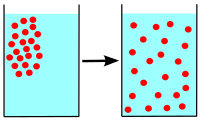
Photo from wikipedia
Abstract A liquid pyrolysis model was implemented into Fire Dynamics Simulator (FDS) to predict burning fluxes in multicomponent pool fires. The model was validated against steady-state pool fire data for… Click to show full abstract
Abstract A liquid pyrolysis model was implemented into Fire Dynamics Simulator (FDS) to predict burning fluxes in multicomponent pool fires. The model was validated against steady-state pool fire data for ethanol-water, ethanol-isopropanol, and ethanol-hexane mixtures. Simulations were also compared to transient ethanol-heptane pool fire data from researchers at the State Key Laboratory of Fire Science in Hefei, China. A mesh sensitivity study on an ethanol-hexane pool fire with a user-defined burning rate showed adequate flame temperature and flame height predictions when using a 20 mm cell size and the default gas phase simulation settings in FDS. FDS simulations using the pyrolysis model reproduced the relationships between fuel composition and maximum burning rate from the steady-state experiments. However, the 20 mm mesh resolution predicted inaccurate self-extinction of ethanol-water pool fires, and a 5 mm cell size was required to model the full range of ethanol-water mixtures. FDS simulations also reproduced temporal changes in fire dynamics that occurred in the transient ethanol-heptane fire experiments. The new methodology enables the simulation of multicomponent pool fires and the evaluation of distillation effects on fire dynamics. However, the primary limitation is that the developed pyrolysis model neglects mass transfer resistances and transient heating of the pool.
Journal Title: Fire Safety Journal
Year Published: 2021
Link to full text (if available)
Share on Social Media: Sign Up to like & get
recommendations!